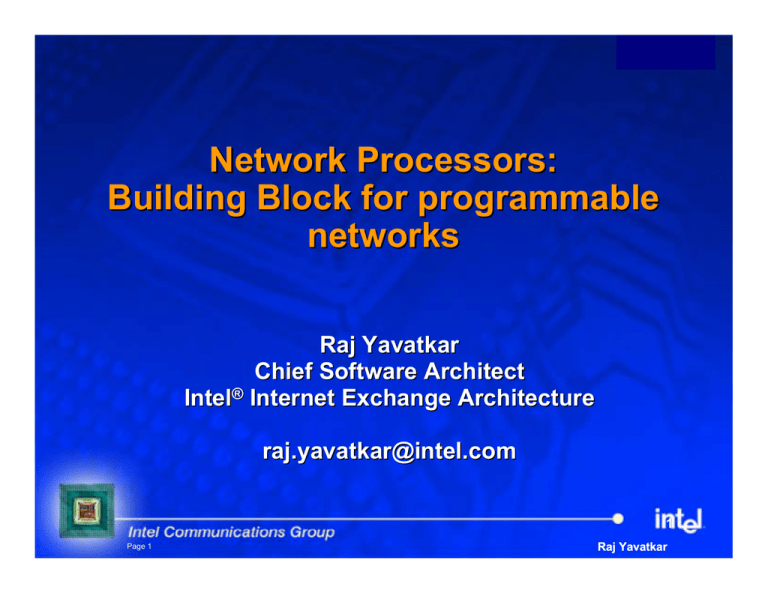Network Processors: Building Block for programmable networks
advertisement

Network Processors: Building Block for programmable networks Raj Yavatkar Chief Software Architect Intel® Internet Exchange Architecture raj.yavatkar@intel.com 1 Page 1 Raj Yavatkar Outline y y y y IXP 2xxx hardware architecture IXA software architecture Usage questions Research questions Page 2 Raj Yavatkar IXP Network Processors Control Processor ME n ME 2 StrongARM ME 1 Media/Fabric Interface y Microengines – RISC processors optimized for packet processing – Hardware support for multi-threading y Embedded StrongARM/Xscale Page 3 DRAM SRAM – Runs embedded OS and handles exception tasks Raj Yavatkar IXP: A Building Block for Network Systems y Example: IXP2800 – – – – – – 16 micro-engines + XScale core Up to 1.4 Ghz ME speed 8 HW threads/ME 4K control store per ME Multi-level memory hierarchy Multiple inter-processor communication channels y NPU vs. GPU tradeoffs – Reduce core complexity – No hardware caching – Simpler instructions Î shallow pipelines – Multiple cores with HW multithreading per chip Page 4 RDRAM Controller Multi-threaded (x8) Microengine Array MEv2 MEv2 MEv2 MEv2 1 2 3 4 Intel® PCI XScale™ Core QDR SRAM Controller Media Switch Fabric I/F MEv2 MEv2 MEv2 MEv2 8 7 6 5 MEv2 MEv2 MEv2 MEv2 9 10 11 12 MEv2 MEv2 MEv2 MEv2 16 15 14 13 Per-Engine Memory, CAM, Signals Interconnect Scratch Memory Hash Unit Raj Yavatkar IXP 2400 Block Diagram Page 5 Raj Yavatkar XScale Core processor y Compliant with the ARM V5TE architecture – support for ARM’s thumb instructions – support for Digital Signal Processing (DSP) enhancements to the instruction set – Intel’s improvements to the internal pipeline to improve the memory-latency hiding abilities of the core – does not implement the floating-point instructions of the ARM V5 instruction set Page 6 Raj Yavatkar Microengines – RISC processors y IXP 2800 has 16 microengines, organized into 4 clusters (4 MEs per cluster) y ME instruction set specifically tuned for processing network data – Arithmetic and Logical operations that operate at bit, byte, and longword levels – can be combined with shift and rotate operations in single instructions. – integer multiplication provided; no division or FP operations y 40-bit x 4K control store y six-stage pipeline in an instruction – On an average takes one cycle to execute y Each ME has eight hardware-assisted threads of execution – can be configured to use either all eight threads or only four threads y The non-preemptive hardware thread arbiter swaps between threads in round-robin order Page 7 Raj Yavatkar MicroEngine v2 D-Push Bus From Next Neighbor Local Memory 128 GPR 128 GPR 128 Next Neighbor S-Push Bus 128 D Xfer In 128 S Xfer In 640 words LM Addr 1 LM Addr 0 2 per CTX B_op 4K Instructions A_op Prev B Control Store Prev A P-Random # CRC remain Local CSRs Multiply Find first bit Add, shift, logical 32-bit Execution Data Path TAGs 0-15 Lock 0-15 Status ALU_Out Status and LRU Logic (6-bit) CAM CRC Unit B_Operand A_Operand Entry# To Next Neighbor Timers Timestamp 128 D Xfer Out D-Pull Bus Page 8 128 S Xfer Out S-Pull Bus Raj Yavatkar Why mult-ithreading? Page 9 Raj Yavatkar Packet processing using multi-threading within a MicroEngine Page 10 Raj Yavatkar Registers available to each ME y four different types of registers – general purpose, SRAM transfer, DRAM transfer, nextneighbor (NN) – Also, access to many CSRs y 256, 32-bit GPRs – can be accessed in thread-local or absolute mode y 256, 32-bit SRAM transfer registers. – used to read/write to all functional units on the IXP2xxx except the DRAM y 256, 32-bit DRAM transfer registers – divided equally into read-only and write-only – used exclusively for communication between the MEs and the DRAM y Benefit of having separate transfer and GPRs – ME can continue processing with GPRs while other functional units read and write the transfer registers Page 11 Raj Yavatkar Next-Neighbor Registers y Each ME has 128, 32-bit next-neighbor registers – makes data written in these registers available in the next microengine (numerically) – E.g., if ME 0 writes data into a next-neighbor register, ME 1 can read the data from its next-neighbor register, and so on y In another mode, these registers are used as extra GPRs – Data written into a next-neighbor register is read back by the same microengine Page 12 Raj Yavatkar Generalized thread signaling y Each ME thread has 15 numbered signals. y Most accesses to functional units outside of the ME can cause a signal to any one signal number y The signal number generated for any functional unit access is under the programmer’s control y A ME thread can test for the presence or absence of any of these signals – used to control branching on the signal presence – Or, to specify to the thread arbiter that a ME thread is ready to run only after the signal is received y Benefit of the approach – software can have multiple outstanding references to the same unit and wait for all of them to complete using different signals Page 13 Raj Yavatkar Different Types of Memory Type of Memory Logical width (bytes) Size in bytes Local to ME 4 2560 Approx unloaded latency (cycles) 3 On-chip scratch 4 16K 60 SRAM 4 256M 150 DRAM 8 2G 300 Page 14 Special Notes Indexed addressing post incr/decr Atomic ops 16 rings w/at. get/put Atomic ops 64-elem qarray Direct path to/fro MSF Raj Yavatkar IXP2800 Features y Half Duplex OC-192 / 10 Gb/sec Ethernet Network Processor y XScale Core – 700 MHz (half the ME) – 32 Kbytes instruction cache / 32 Kbytes data cache y Media / Switch Fabric Interface – 2 x 16 bit LVDS Transmit & Receive – Configured as CSIX-L2 or SPI-4 y PCI Interface – 64 bit / 66 MHz Interface for Control – 3 DMA Channels y QDR Interface (w/Parity) – – – (4) 36 bit SRAM Channels (QDR or Co-Processor) Network Processor Forum LookAside-1 Standard Interface Using a “clamshell” topology both Memory and Co-processor can be instantiated on same channel y RDR Interface – – – Page 15 (3) Independent Direct Rambus DRAM Interfaces Supports 4i Banks or 16 interleaved Banks Supports 16/32 Byte bursts Raj Yavatkar Hardware Features to ease packet processing y Ring Buffers – For inter-block communication/synchronization – Producer-consumer paradigm y Next Neighbor Registers and Signaling – Allows for single cycle transfer of context to the next logical micro-engine to dramatically improve performance – Simple, easy transfer of state y Distributed data caching within each micro-engine – Allows for all threads to keep processing even when multiple threads are accessing the same data Page 16 Raj Yavatkar Outline y y y y IXP 2xxx hardware architecture IXA software architecture Usage questions Research questions Page 17 Raj Yavatkar IXA Portability Framework - Goals y Accelerate software development for the IXP family of network processors y Provide a simple and consistent infrastructure to write networking applications y Enable reuse of code across applications written to the framework y Improve portability of code across the IXP family y Provide an infrastructure for third parties to supply code – for example, to support TCAMs Page 18 Raj Yavatkar IXA Software Framework External Processors Control Plane Protocol Stacks Control Plane PDK XScale™ Core Core Components C/C++ Language Core Component Library Resource Manager Library Microblock Library Microengine Pipeline Micro block Micro block Protocol Library Micro block Microengine C Language Utility Library Hardware Abstraction Library Page 19 Raj Yavatkar Software Framework on the MEv2 y Microengine C compiler (language) y Optimized Data Plane Libraries – Microcode and MicroC library for commonly used functions y Microblock Programming Model – Enables development of modular code building blocks – Defines the data flow model, common data structures, state sharing between code blocks etc – Ensures consistency and improves reuse across different apps y Core component library – Provides a common way of writing slow-path components that interact with their counterpart fast-path code y Microblocks and example applications written to the microblock programming model – IPv4/IPv6 Forwarding, MPLS, DiffServ etc. Page 20 Raj Yavatkar Micro-engine C Compiler y C language constructs – Basic types, pointers, bit fields y In-line assembly code support y Aggregates – Structs, unions, arrays – Intrinsics for specialized ME functions – Different memory models and special constructs for data placement (e.g., __declspec(sdram) struct msg_hdr hd) Page 21 Raj Yavatkar What is a Microblock? y Data plane packet processing on the microengines is divided into logical functions called microblocks y Coarse Grain and stateful y Example – 5-Tuple Classification – IPv4 Forwarding – NAT y Several microblocks running on a microengine thread can be combined into a microblock group. – A microblock group has a dispatch loop that defines the dataflow for packets between microblocks – A microblock group runs on each thread of one or more microengines y Microblocks can send and receive packets to/from an associated Xscale Core Component Page 22 Raj Yavatkar Core Components and Microblocks XScale™ Core Core Component Core Component Core Component Core Component Library Resource Manager Library Microblock Library Microengines Microblock Microblock Library Page 23 Microblock Intel/3rd party blocks Microblock User-written code Core Libraries Raj Yavatkar Simplified Packet Flow (IPv6 example) DRAM Rx a. Put Packet in DRAM b. Put Descriptor in SRAM c. Queue Handle on ring SRAM H Ethernet Header H IPv6 Header Offset Offset Size Size Payload … Packet Buffers Buffer Descriptors Local Memory Ethernet Header IPv6 Header Header Cache Scratch Ring Handle H Prefix next-hop-id 3FFF020304 N N Interface# Source d. Pull meta-data in GPRs Flags e. Set DL state in GPRs … DMAC f. Set next_blk = Classify … …. Classify g. Get Headers in HCache h.Set HeaderType to IPv6 Next-Hop Route Table i. Set next_blk = IPv6 IPv6 j. Get DAddr from HCache GPRs k. Search RouteTable l. Set next-hop-id = N Offset, size m. Set next_blk = Encap dl_buff_handle H Header-Type IPV6 Encap dl_next_block 432 Next-hop-id N n. Get DMAC from next-hop N o. Set Eth Hdr in HCache DL state Meta-data p. Flush HCache to DRAM Scratch Ring Sink q. Flush Meta-data to SRAM PP Microblock-group r. Queue Handle to Ring Offset Rx Size Port Descriptor Source Classify IPv6 Encap (2) (3) (4) Sink Handle Outport Descriptor or NextNeighbor Animation: press PgDn 19 times (PgUp to backup) Page 24 Raj Yavatkar Outline y y y y IXP 2xxx hardware architecture IXA software architecture Usage questions Research questions Page 25 Raj Yavatkar What can I do with an IXP? y Fully programmable architecture – Implement any packet processing applications – Examples from customers – Routing/switching, VPN, DSLAM, Multi-servioce switch, storage, content processing – Intrusion Detection (IDS) and RMON – needs processing of many state elements in parallel – Use as a research platform – Experiment with new algorithms, protocols – Use as a teaching tool – Understand architectural issues – Gain hands-on experience withy networking systems Page 26 Raj Yavatkar Technical and Business Challenges y Technical Challengers – Shift from ASIC-based paradigm to software-based apps – Challenges in programming an NPU (next) – Trade-off between power, board cost, and no. of NPUs – How to add co-processors for additional functions? y Business challenges – Reliance on an outside supplier for the key component – Preserving intellectual property advantages – Add value and differentiation through software algorithms in data plane, control plane, services plane functionality – Must decrease TTM to be competitive (To NPU or not to NPU?) Page 27 Raj Yavatkar Outline y y y y IXP 2xxx hardware architecture IXA software architecture Usage questions Research questions Page 28 Raj Yavatkar Architectural Issues y How to scale up to OC-768 and beyond? y What is the “right” architecture? – A set of reconfigurable processing engines vs carefully architected pipelined stages vs a set of fixed-function blocks y Questionable hypotheses – No locality in packet processing? – Temporal vs spatial – Working set size vs available cache capacity – Little or no dependency in packets from different flows? Page 29 Raj Yavatkar Challenges in Programming an NP y Distributed, parallel programming model – Multiple microengines, multiple threads y Wide variety of resources – Multiple memory types (latencies, sizes) – Special-purpose engines – Global and local synchronization y Significantly different from the problem seen in scientific computing Page 30 Raj Yavatkar NPU Programming Challenges y Programming environments for NPUs and network systems are different from those for conventional multi-processors y Automatic allocation of network system resources: Memory Conventional MP systems y Rely on locality of memory accesses to utilize memory hierarchy effectively y y y Programmers program to a single-level memory hierarchy y Compilers are unaware of the memory levels or their performance characteristics Memory Memorymanagement managementisismore morecomplex complex ininnetwork systems network systems Page 31 y Network systems Packet processing applications demonstrate little temporal locality Minimizing memory access latencies is crucial Compilers should manage memory hierarchy explicitly – Allocate data structures to appropriate memory levels – Allocation depends on data structure sizes, access pattern, sharing requirements, memory system characteristics, … Raj Yavatkar NPU Challenges - 2 y Automatic allocation of network system resources: Processors Conventional MP systems Network systems y Parallel compilers exploit loopor function-level parallelism to utilize multiple processors to speed-up execution of programs y Individual packet processing is inherently sequential; little loopor function-level parallelism y Operating systems utilize idle processors to execute multiple programs in parallel y Process packets belonging to different flows in parallel y High-throughput and robustness requirements – Compilers should create efficient packet processing pipelines Network Networkapplications applicationsare areexplicitly explicitlyparallel parallelÎ Î concurrency concurrencyextraction extractionisissimpler; simpler; but butthroughput throughputand androbustness robustnessrequirements requirements introduce a new problem of pipeline introduce a new problem of pipelineconstruction construction! ! Page 32 – Granularity of pipeline stage depends on instruction cache size, amount of communication between stages, computational complexity of stages, sharing and synchronization requirements, … Raj Yavatkar Challenges (contd.) y How to enable a wide range of network applications – TCP offload/termination – How to distribute functionality between SA/Xscale, Pentium, and microengines? – Hierarchy of compute vs I/O capabilities – How to allow use of multiple IXPs to solve more compute intensive problems y Networking research – How to take advantage of programmable, open architecture? – Designing “right” algorithms for LPM, range matching, string search, etc – QoS-related algorithms – TM4.1, WRED, etc Page 33 Raj Yavatkar Questions? Page 34 Raj Yavatkar



